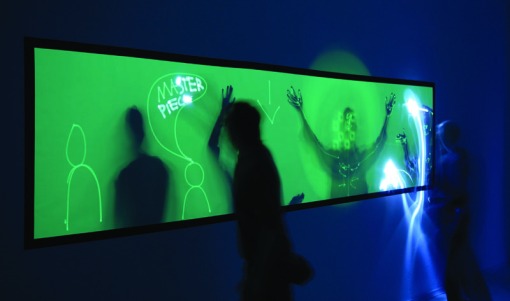The project is influenced by author’s interest in the phenomenon of the photoluminescent and fluorescent materials. These materials (PTL-photoluminescent) need minimum energy to glare. They are basically accumulative glaring self-charging batteries.

Draw it! Write it down! Make confidence… The room, in which the foil is tightly attached to the wall, is darkened. The foil is basically a big picture, an outsized canvas. A visitor / spectator obtains a torch with thin but strong ray of light before entering. The torch is substitution for brush – it is unique light brush painting. A spectator entering the room is able to paint or write with the brush / ray of light on the very canvas (PTL- foil). She is a co-creator of the work. Her supposed perception is deepened by the experience of the actual participation / creation. She has the opportunity to leave her own print in the sacred place of the gallery. It is not only passive interaction based on the movements or sound made by a visitor that brings to life an action or some kind of pre-programmed mechanisms. Also it is not any random generative process. You create!
ASPECT OF ILLUMINOSITY: First divine creation was Light… Let there be Light! In the materialistic but also spiritual sense Light is elementary quality. The game of light cheers up. A spectator has unrepeatable feeling while looking at the beam leaving luminous track behind it. It is all about discovering a game and its system. How to create with a ray of light? A spectator does not create only for herself, but for others, present visitors, and those who will come after she leaves. That makes a field for reaction: interception with previous drawings and messages. The canvas would never be full, because as time proceeds, a track of light would disappear, as the crystals discharge.
ASPECT OF IMPERMANENCY: The effect reflects another aspect of Kleník’s work, and that is its dependency on time: its flashiness and uniqueness. A drawer realizes impermanency of her draws, but also possibility of laminating these draws. The third dimension of the drawing/writing occurs – time. Particular drawings slowly disappear in the distance (dark); its fading into the background creates feeling of three dimensions. We see previous sketches disappearing. For newcomers they would be forever secret.
The author does not offer a clear message, concept or a thought: He lets the spectator participate, become a part of the work and enjoy herself. Kleník lets him co-create her own adventure / memory. Hence, language of art makes sense only when there is someone who understands it, or at least tries to decode it, in this case a spectator co-creates the actual language. She must understand it.

Czech, 1978, http://www.umakart.cz, studied philosophy of art at Charles University in Prague, currently a student of New Media Department at the Fine Arts Academy in Prague. His works mainly reflect the relationship between world of art and its consumers.